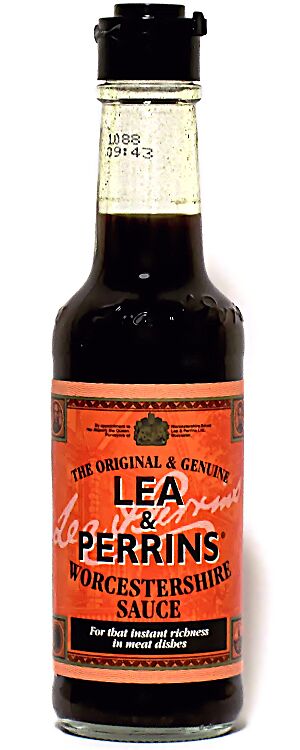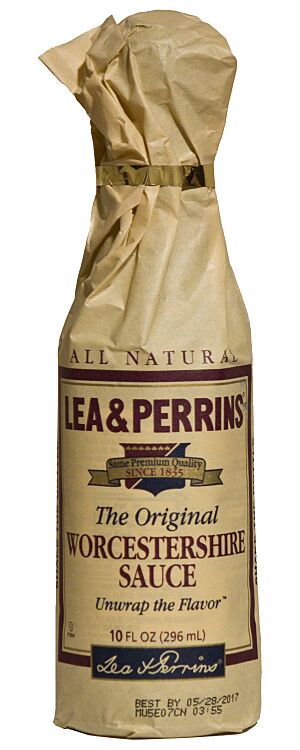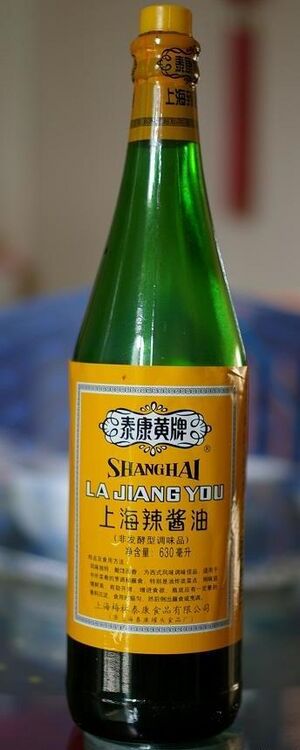Worcestershire sauce facts for kids

Worcestershire sauce in a dish
|
|
| Alternative names | Worcester sauce |
|---|---|
| Type | Condiment |
| Created by |
|
| Main ingredients | |
Worcestershire sauce, also called Worcester sauce, is a special liquid seasoning. It's made by letting ingredients ferment, which means they change over time, like how yogurt or pickles are made. This sauce was created by two pharmacists, John Wheeley Lea and William Henry Perrins, in Worcester, England, in the early 1800s. They later started the famous company Lea & Perrins.
Since 1876, "Worcestershire sauce" has been a general name for this type of sauce. This means that Lea & Perrins doesn't own the name itself. Other companies can also make and sell their own Worcestershire sauce.
People use Worcestershire sauce in many ways. You can drizzle it directly on foods like steaks or hamburgers. It's also a key ingredient in drinks like the Bloody Mary. Chefs often add it to recipes such as Caesar salad or beef stew to give them a rich, savory flavor. This savory taste is known as umami.
Contents
The Story Behind the Sauce
People have made fermented fish sauces for a very long time, even in ancient times. In the 1600s, English recipes already mixed anchovies with other ingredients to make sauces for fish.
How Lea & Perrins Began
The Lea & Perrins brand of Worcestershire sauce first became available in 1837. It was the first sauce to use the "Worcestershire" name. The exact story of how Lea & Perrins got their recipe isn't fully clear. The original bottles said the sauce came from a "nobleman in the county."
The company also has a story that a "Lord Sandys" found the recipe in India in the 1830s. He supposedly asked the pharmacists, John Wheeley Lea and William Perrins, to make it for him. However, records don't show that any Lord Sandys was ever a governor in India or even visited there.
The Happy Accident
According to a popular story, when the pharmacists first mixed the sauce, it tasted so strong that they thought it was awful. They put the barrel in their basement and forgot about it. About 18 months later, they found the barrel while cleaning. They decided to try the sauce again and were amazed! The long time spent fermenting had made the sauce much milder and delicious. In 1838, the first bottles of Lea & Perrins Worcestershire sauce were sold to the public.
What's in Worcestershire Sauce?
The ingredients in Worcestershire sauce can be different depending on who makes it. But usually, it includes vinegar, salt, and something sweet like sugar or molasses. It also has flavorful ingredients like garlic, onions, and often soy sauce or fish sauce. Some versions might have tamarind, chili peppers, or spices like cloves.
Fish-Free Options
Since traditional Worcestershire sauce often contains anchovies (a type of fish), there are also vegetarian and vegan versions available. These don't use fish, which is helpful for people who don't eat fish or are allergic to it. For safety, some food rules suggest that foods with Worcestershire sauce containing fish should have a warning label.
Some Jewish dietary laws mean that traditional Worcestershire sauce isn't used with meat dishes. However, some brands are made in a way that they can be used.
While soy sauce is in many Worcestershire sauces today, it's debated if Lea & Perrins always used it. During World War II, Lea & Perrins did use a different ingredient because of shortages. As of 2021, soy is not listed as an ingredient in Lea & Perrins sauce.
Different Kinds of Worcestershire Sauce
Lea & Perrins Sauce
The Lea & Perrins brand is still the most popular Worcestershire sauce around the world.
In 1897, Lea & Perrins moved their sauce making from their pharmacy to a factory in Worcester, England. The sauce is still made there today. The factory makes bottles for local sales and also a concentrated version that is sent to other countries to be bottled.
Over the years, the company that owns Lea & Perrins has changed hands several times. It was bought by HP Foods in 1930, then by Imperial Tobacco in 1967. Later, it was sold to Danone in 1988, and then to Heinz in 2005. Today, Kraft Heinz sells Lea & Perrins Worcestershire Sauce in the United States.
In the United States, some Lea & Perrins bottles come in dark glass with a beige label, wrapped in paper. This tradition comes from how the sauce was shipped from England long ago, to protect the bottles. The company says their Worcestershire sauce is the oldest bottled seasoning sold in the U.S. The ingredients in the US version are a bit different from the UK and Canadian versions. For example, the US version uses distilled white vinegar instead of malt vinegar.
Worcestershire Sauce Around the World
- Brazil and Portugal: It's called molho inglês, which means 'English sauce'.
- Costa Rica: They have their own special version called Salsa Lizano, created in 1920. It's a very common sauce in homes and restaurants there.
- El Salvador: It's very popular here, known as salsa inglesa ('English sauce') or salsa Perrins. Many restaurants have a bottle on every table.
- Germany: A sweeter, less salty version called Worcestersauce Dresdner Art was made in Dresden in the early 1900s. It has less anchovy and is mostly eaten in eastern Germany.
- Mexico: It's known as salsa inglesa (English sauce).
- United Kingdom, Australia: Holbrook's Worcestershire sauce started in England in 1875. Now, only the Australian part of the company still makes it. It's very popular in Australia.
- United States: Besides Lea & Perrins, another brand called French's started making Worcestershire sauce in 1941.
- Venezuela: It's commonly called salsa inglesa ('English sauce') and is used in traditional dishes like Hallacas.
Worcestershire Sauces Without Fish
Some sauces are inspired by Worcestershire sauce but don't use fish.
- Thailand: Gy-Nguang Worcestershire sauce has been made since 1917. It uses soy sauce instead of anchovies for the savory taste. They have two versions: Formula 1 for Asian tastes and Formula 2 for international tastes.
- Japan: In Japan, it's called Worcester (ウスターソース). Many Japanese versions are vegetarian, using water, syrup, vinegar, and fruit purees like apple and tomato. They are often less spicy and sweeter. Japanese sauces are also grouped by how thick they are.
- Tonkatsu sauce is a thicker, Worcester-style sauce made from vegetables and fruits. It's often served with a dish called tonkatsu.
- China: Worcestershire sauce has been introduced to Chinese-speaking areas multiple times, leading to different versions:
- Spicy soy sauce (辣酱油) in Shanghai: This was first made in 1933. The Taikang Yellow sauce, available today, doesn't have fish. It's used in Shanghai cooking, especially with pork chops.
- Gip-sauce (喼汁) in Hong Kong: This version often has a stronger savory taste from added soy sauce, fish sauce, or MSG. Some don't use fish at all. It's common in dim sum dishes like steamed meatballs.
- Spicy vinegar (辣香酢) in Taiwan: This sauce came from the Japanese Worcester sauce. It's also sometimes called Taiwan Black Vinegar.
See also
 In Spanish: Salsa Worcestershire para niños
In Spanish: Salsa Worcestershire para niños
- A.1. Steak Sauce
- Fish sauce
- Oyster sauce
- Soy sauce
- Henderson's Relish – a similar sauce without fish
- List of sauces





